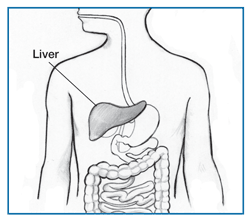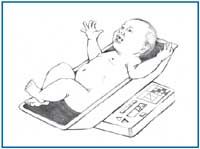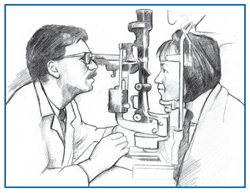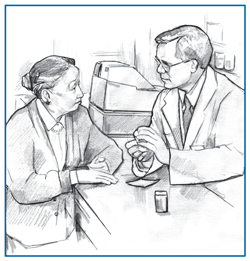
|
Other sections: Abbreviations — Commentaries — Diabetes Info — Dictionary — Magazines & Journals — Press Releases — Websites
Llactic acidosis (LAK-tik) (ASS-ih-DOH-siss): a serious condition in which there is a buildup of lactic acid in the body. Lactic acidosis can result from diabetic ketoacidosis, liver disease, or kidney disease.LADA (LAH-DUH): see latent autoimmune diabetes in adults. lancet (LAN-set): a spring-loaded device used to prick the skin with a small needle to obtain a drop of blood for blood glucose monitoring. Lantus (LAN-tuhss): Brand name of an insulin product. See insulin glargine. For more information, see Types of Insulin. laser treatment: a type of therapy that uses a strong beam of light to treat a damaged area. The beam of light is called a laser. A laser is sometimes used to seal blood vessels in the eye of a person with diabetes. See photocoagulation. latent autoimmune diabetes in adults (LADA) (LAY-tent) (AW-toh-ih-MYOON) (DY-uh-BEE-teez) (in) (uh-DUHLTS): a type of diabetes, usually first diagnosed after age 30. Most people with LADA still produce their own insulin when first diagnosed and hence initially do not require exogenous insulin injections. Probably a slowly-developing variant of type 1 diabetes. For more information, see Latent Autoimmune Diabetes in Adults. LDL cholesterol (EL-DEE-EL) (koh-LESS-tur-ol): stands for low-density lipoprotein cholesterol; a fat found in the blood that takes cholesterol around the body to where it is needed for cell repair and also deposits it on the inside of artery walls. Sometimes called "bad" cholesterol. For more information, see What You Need To Know About High Blood Cholesterol. Levemir (LEV-uh-mihr): Brand name of an insulin product. See insulin detemir. For more information, see Types of Insulin. limited joint mobility: a condition in which the joints swell and the skin of the hand becomes thick, tight, and waxy, making the joints less able to move. It may affect the fingers and arms as well as other joints in the body. linagliptin (LINN-ah-GLIP-tin): an oral medicine used to treat type 2 diabetes. Linagliptin lowers blood glucose by helping the body make more insulin when it's needed. It also helps keep the liver from putting stored glucose into the blood. Sitagliptin belongs to the class of medicines called DPP-4 inhibitors. (Brand name: Trajenta.) For more information, see DPP-4 Inhibitors. lipid (LIP-id): a term for fat in the body. Lipids can be broken down by the body and used for energy. lipid profile (LIP-id) (PROH-fyl): a blood test that measures total cholesterol, triglycerides, and HDL cholesterol. LDL cholesterol is then calculated from the results. A lipid profile is one measure of a person's risk of cardiovascular disease. For more information, see What You Need To Know About High Blood Cholesterol. lipoatrophy (LIP-oh-AT-roh-fee): loss of fat under the skin resulting in small dents. Lipoatrophy may be caused by repeated injections of insulin in the same spot. lipodystrophy (LIP-oh-DISS-troh-fee): defect in the breaking down or building up of fat below the surface of the skin, resulting in lumps or small dents in the skin surface. Lipodystrophy may be caused by repeated injections of insulin in the same spot. See lipoatrophy and lipohypertrophy. lipohypertrophy (LIP-oh-hy-PUR-troh-fee): buildup of fat below the surface of the skin, causing lumps. Lipohypertrophy may be caused by repeated injections of insulin in the same spot. liragluide (lir-AGH-glue-tyd): an injectable medicine for diabetes that mimics the effect of incretin hormones, a type of gastrointestinal hormone. This medicine helps food move more slowly through the stomach and helps keep the liver from releasing stored glucose. (Brand name: Victoza.) For more information, see Incretin Mimetics. liver: an organ in the body that changes food into energy, removes alcohol and poisons from the blood, and makes bile, a substance that breaks down fats and helps rid the body of wastes.
long-acting insulin (long-AK-ting) (IN-suh-lin): a type of insulin with an onset of 1 hour, no pronounced peak, and a duration of 20 to 26 hours. See insulin detemir and insulin glargine. For more information, see Types of Insulin. low blood glucose (loh) (bluhd) (GLOO-kohss): see hypoglycemia. low blood pressure: see hypotension. low-density lipoprotein cholesterol (LOH-DEN-sih-tee) (LIP-oh-PROH-teen) (koh-LESS-tur-ol): see LDL cholesterol. lymphatic vessels (lim-FAT-ik) (VESS-uhlz): thin tubes in the body that carry white blood cells and lymphatic fluid. Lymphatic fluid has cells that fight infection. 
Mmacrosomia (MAK-roh-SOH-mee-uh): abnormally large; in diabetes, refers to abnormally large babies that may be born to women with diabetes.
macrovascular disease (MAK-roh-VASS-kyoo-lur) (dih-ZEEZ): disease of the large blood vessels, such as those found in the heart. Lipids and blood clots build up in the large blood vessels and can cause atherosclerosis, coronary heart disease, stroke, and peripheral vascular disease. macula (MAK-yoo-luh): the part of the retina in the eye used for reading and seeing fine detail. macular edema (MAK-yoo-lur) (eh-DEE-muh): swelling of the macula. maturity-onset diabetes of the young (MODY) (muh-CHUR-ih-tee-AWN-set) (DY-uh-BEE-teez) (uhv) (thuh) (yuhng): a monogenic form of diabetes that usually first occurs during adolescence or early adulthood. For more information, see Monogenic Forms of Diabetes: Neonatal Diabetes Mellitus and Maturity-onset Diabetes of the Young. meglitinide (meh-GLIH-tih-nyd): a type of oral medicine for type 2 diabetes that lowers blood glucose by helping the pancreas make more insulin right after meals. (Generic name/Brand name: repaglinide/Prandin.) metabolic syndrome (MET-uh-BOL-ik) (SIN-drohm): a grouping of health conditions associated with an increased risk for heart disease and type 2 diabetes. Conditions include hypertension, a large waist, high triglyceride levels, low HDL cholesterol levels, and above-normal blood glucose levels. Metabolic syndrome was previously called Syndrome X. metabolism (meh-TAB-oh-lizm): all of the chemical and physical processes in the body necessary for life. Processes include breaking down food for energy and producing needed substances. Metaglip (MET-uh-glip): the brand name of an oral medicine used to treat type 2 diabetes; a combination of glipizide and metformin. For more information, see Combination Diabetes Pills. metformin (met-FOR-min): an oral medicine used to treat type 2 diabetes. Metaformin lowers blood glucose by reducing the amount of glucose produced by the liver and helping the body respond better to the insulin made in the pancreas. Metaformin belongs to the class of medicines called biguanides. (Brand names: Glucophage, Glucophage XR, Riomet.) For more information, see Biguanides. mg/dL: milligrams per deciliter (MIL-ih-gramz) (pur) (DESS-ih-lee-tur); a unit of measure that shows the concentration of a substance in a specific amount of fluid. In the United States, blood glucose test results are reported as mg/dL. Medical journals and other countries use millimoles per liter (mmol/L). To convert to mg/dL from mmol/L, multiply mmol/L by 18. Example: 10 mmol/L × 18 = 180 mg/dL. microalbumin (MY-kroh-al-BYOO-min): small amounts of the protein called albumin in the urine detectable with a special laboratory test. See albumin. microaneurysm (MY-kroh-AN-yoo-rizm): a small swelling that forms on the side of tiny blood vessels. These small swellings may break and allow blood to leak into nearby tissue. People with diabetes may get microaneurysms in the retina of the eye. Micronase (MY-kroh-nayz): see glyburide. For more information, see Sulfonylureas. microvascular disease (MY-kroh-VASS-kyoo-lur) (dih-ZEEZ): disease of the smallest blood vessels, such as those found in the eyes, nerves, and kidneys. The walls of the vessels become abnormally thick but weak. Then they bleed, leak protein, and slow the flow of blood to the cells. miglitol (MIG-lih-tol): an oral medicine used to treat type 2 diabetes. Miglitol slows down the digestion of foods high in carbohydrate, such as rice, bread, milk, and fruit. The result is a slower and lower rise in blood glucose after meals. Miglitol belongs to the class of medicines called alpha-glucosidase inhibitors. (Brand name: Glyset.) For more information, see Alpha-Glucosidase Inhibitors. mixed dose: a combination of two types of insulin in one injection. Usually a rapid- or short-acting insulin is combined with a longer-acting insulin to provide both short- and long-term control of blood glucose levels. mmol/L: millimoles per liter (MIL-ih-mohlz) (pur) (LEE-tur); a unit of measure that shows the concentration of a substance in a specific amount of fluid. In most of the world, except for the United States, blood glucose test results are reported as mmol/L. In the United States, milligrams per deciliter (mg/dL) is used. To convert to mmol/L from mg/dL, divide mg/dL by 18. Example: 180 mg/dL ÷ 18 = 10 mmol/L. MODY (MOH-dee): maturity-onset diabetes of the young. For more information, see Monogenic Forms of Diabetes: Neonatal Diabetes Mellitus and Maturity-onset Diabetes of the Young. monitor: see blood glucose meter. monofilament (MON-oh-FIL-uh-ment): a short piece of nylon, like a hairbrush bristle, mounted on a wand. To check sensitivity of the nerves in the foot, the doctor touches the filament to the bottom of the foot. monogenic (MON-oh-JEN-ik): related to a single gene. Some rare forms of diabetes are monogenic, including neonatal diabetes mellitus and maturity-onset diabetes of the young (MODY). mononeuropathy (MON-oh-noo-ROP-uh-thee): a type of neuropathy affecting a single nerve. myocardial infarction (MY-oh-KAR-dee-uhl) (in-FARK-shuhn): see heart attack. 
NNAFLD (EN-AY-EF-EL-DEE): see nonalcoholic fatty liver disease.NASH (nuhsh): see nonalcoholic steatohepatitis. nateglinide (nuh-TEG-lih-nyd): an oral medicine used to treat type 2 diabetes. Nateglinide lowers blood glucose levels by helping the pancreas make more insulin right after meals. Nateglinide belongs to the class of medicines called D-phenylalanine derivatives. (Brand name: Starlix.) For more information, see D-Phenylalanine Derivative. NDM: see neonatal diabetes mellitus. necrobiosis lipoidica diabeticorum (NEK-roh-by-OH-siss) (lih-POY-dih-kuh) (DY-uh-bet-ih-KOR-uhm): a skin condition usually on the lower part of the legs. Lesions can be small or extend over a large area. They are usually raised, yellow, and waxy in appearance and often have a purple border. neonatal diabetes mellitus (NDM) (NEE-oh-NAY-tuhl) (DY-uh-BEE-teez) (MEH-luh-tuhss): a rare, monogenic form of diabetes that occurs in the first 6 months of life. In about half of those with NDM, the condition is lifelong and is called permanent neonatal diabetes mellitus (PNDM). In the rest of those with NDM, the condition is transient and disappears during infancy but can reappear later in life; this type of NDM is called transient neonatal diabetes mellitus (TNDM). neotame (NEE-oh-taym): a dietary sweetener with no calories and no nutritional value. neovascularization (NEE-oh-VASS-kyoo-lar-ih-ZAY-shuhn): the growth of new, small blood vessels. In the retina, this may lead to vision loss or blindness. nephrologist (neh-FROL-uh-jist): a doctor who treats people who have kidney problems. nephropathy (neh-FROP-uh-thee): disease of the kidneys. Hyperglycemia and hypertension can damage the kidneys' glomeruli. When the kidneys are damaged, protein leaks out of the kidneys into the urine. Damaged kidneys can no longer remove wastes and extra fluid from the bloodstream. nerve conduction studies: tests used to measure for nerve damage; one way to diagnose neuropathy. nerve disease: see neuropathy. neurogenic bladder (NOO-roh-JEN-ik) (BLAD-ur): loss of bladder control caused by damage to the nerves controlling the bladder. neurologist (noo-ROL-uh-jist): a doctor who specializes in problems of the nervous system, such as neuropathy. neuropathy (noo-ROP-uh-thee): disease of the nervous system. The three major forms in people with diabetes are peripheral neuropathy, autonomic neuropathy, and mononeuropathy. The most common form is peripheral neuropathy, which affects the legs and feet. For more information, see The Nerve Damage of Diabetes. NIDDM (EN-EYE-DEE-DEE-EM): noninsulin-dependent diabetes mellitus. Former term for what is now called type 2 diabetes nonalcoholic fatty liver disease (NAFLD) (NON-al-koh-HOL-ik) (FAT-ee) (LIV-ur) (dih-ZEEZ): fat in the liver. NAFLD can lead to nonalcoholic steatohepatitis (NASH) and chronic liver disease. NAFLD can be a complication of insulin resistance and diabetes. nonalcoholic steatohepatitis (NASH) (NON-al-koh-HOL-ik) (STEE-uh-toh-HEP-uh-TY-tiss): a common liver disease, often without symptoms, that resembles alcoholic liver disease but occurs in people who drink little or no alcohol. The major characteristic of NASH is fat in the liver, along with inflammation and damage. NASH can be a complication of insulin resistance and diabetes. noninsulin-dependent diabetes mellitus (NIDDM) (NON-IN-suh-lin-duh-PEN-dent) (DY-uh-BEE-teez) (MEH-luh-tuhss): former term for type 2 diabetes. noninvasive blood glucose monitoring (NON-in-VAY-siv) (bluhd) (GLOO-kohss) (MON-ih-TUR-ing): measuring blood glucose without pricking the finger to obtain a blood sample. non-obese diabetic (NOD) mice: a strain of mice that exhibit a susceptibility to spontaneous development of autoimmune diabetes mellitus, and have been used as a model in type 1 diabetes research. Novolin 70/30 (NOH-voh-lin): Brand name of an insulin product. See pre-mixed insulin. For more information, see Types of Insulin. Novolin N (NOH-voh-lin): Brand name of an insulin product. See NPH insulin. For more information, see Types of Insulin. Novolin R (NOH-voh-lin): Brand name of an insulin product. See regular insulin. For more information, see Types of Insulin. NovoLog (NOH-voh-lawg): Brand name of an insulin product. See insulin aspart. For more information, see Types of Insulin. NovoLog Mix 70/30 (NOH-voh-lawg) (mix): Brand name of an insulin product. See pre-mixed insulin. For more information, see Types of Insulin. NPH insulin (EN-PEE-AYCH) (IN-suh-lin): an intermediate-acting insulin with an onset of 1 to 3 hours, a peak at 8 hours, and a duration of 12 to 16 hours. Also called N insulin. (Brand names: Humulin N, Novolin N.) For more information, see Types of Insulin. nutritionist (noo-TRISH-uh-nist): a person with training in nutrition; may or may not have specialized training and qualifications. See dietitian. 
Oobesity (oh-BEE-sih-tee): a condition in which a greater than normal amount of fat is in the body; more severe than overweight; having a body mass index of 30 or more.obstetrician (OB-stuh-TRISH-uhn): a doctor who treats pregnant women and delivers babies. OGTT: oral glucose tolerance test. Onglyza (ON-gly-zuh): Brand name of a diabetes medication, saxagliptin. See DPP-4 Inhibitors. onset: in referring to insulin, how soon the insulin starts to lower blood glucose levels after it is taken. Onset may also refer to the time when a person's diabetes began. ophthalmologist (AHF-thal-MOL-uh-jist): a medical doctor who diagnoses and treats all eye diseases and eye disorders. Opthalmologists can also prescribe glasses and contact lenses.
Ophthalmologist
optician (op-TISH-uhn): a health care professional who dispenses glasses and lenses. An optician also makes and fits contact lenses. optometrist (op-TOM-uh-trist): a primary eye care provider who prescribes glasses and contact lenses. Optometrists can diagnose and treat certain eye conditions and diseases. oral glucose tolerance test (OGTT) (OR-uhl) (GLOO-kohss) (TOL-ur-uhnss) (test): a test to diagnose pre-diabetes and diabetes. The oral glucose tolerance test is given by a health care professional after an overnight fast. A blood sample is taken, then the patient drinks a high-glucose beverage. Blood samples are taken at intervals for 2 to 3 hours. Test results are compared with a standard and show how the body uses glucose over time. oral hypoglycemic agents (OR-uhl) (HY-poh-gly-SEE-mik) (AY-jents): medicines taken by mouth by people with type 2 diabetes to keep blood glucose levels as close to normal as possible. Types of oral hypoglycemic agents are alpha-glucosidase inhibitors, biguanides, D-phenylalanine derivatives, DPP-4 inhibitors, meglitinides, sulfonylureas, and thiazolidinediones. overweight: an above-normal body weight; having a body mass index of 25 to 29. 
PPAD (PEE-AY-DEE): peripheral arterial disease.pancreas (PAN-kree-uhss): an organ in the abdomen that contains the islets of Langerhans. The islets make insulin and enzymes for digestion. The pancreas is located behind the lower part of the stomach and is about the size of a hand.
pancreas transplantation (PAN-kree-uhss) (TRANZ-plan-TAY-shuhn): a surgical procedure to take a healthy whole or partial pancreas from a donor and place it into a person with diabetes. pancreatitis (PAN-kree-uh-TY-tiss): an irritation of the pancreas that can cause it to stop working. Pancreatitis can be acute or chronic. Secondary diabetes may develop when pancreatic tissue is destroyed from chronic pancreatitis and the insulin-producing cells of the pancreas, called beta cells, have been damaged. There is an increased incidence of pancreatitis in people with diabetes. Pancreatitis can also occur as a side effect of some diabetes medications. PCOS (PEE-SEE-OH-ESS): polycystic ovary syndrome. For more information, see Polycystic Ovary Syndrome. peak: in referring to insulin speeds, the length of time the insulin is working hardest to lower blood glucose levels. pediatric endocrinologist (PEE-dee-AT-rik) (en-doh-krih-NAH-luh-jist): a doctor who treats children who have endocrine gland problems such as diabetes. pedorthist (ped-OR-thist): a health care professional who specializes in fitting shoes for people with disabilities or deformities. A pedorthist can custom-make shoes or orthotics (special inserts for shoes). pen injector (pen) (in-JEK-tur): a penlike device for injecting insulin; contains a needle and a cartridge of insulin. periodontal disease (PAIR-ee-oh-DON-tuhl) (dih-ZEEZ): disease of the gums. periodontist (PAIR-ee-oh-DON-tist): a dentist who specializes in treating people who have gum diseases. peripheral arterial disease (PAD) (puh-RIF-ur-uhl) (ar-TEE-ree-uhl) (dih-ZEEZ): also called peripheral vascular disease; a condition in which the large blood vessels of the legs are narrowed or blocked by fatty deposits, decreasing blood flow to the legs and feet. PAD increases the chances of amputation, heart attack, and stroke. peripheral neuropathy (puh-RIF-ur-uhl) (noo-ROP-uh-thee): nerve damage that affects the feet, legs, or hands. Peripheral neuropathy causes pain, numbness, or a tingling feeling. peripheral vascular disease (PVD) (puh-RIF-ur-uhl) (VASS-kyoo-lur) (dih-ZEEZ): see peripheral arterial disease. peritoneal dialysis (PAIR-ih-toh-NEE-uhl) (dy-AL-ih-siss): see dialysis. permanent neonatal diabetes mellitus (PNDM) (PUR-muh-nent) (NEE-oh-NAY-tuhl) (DY-uh-BEE-teez) (MEH-luh-tuhss): a rare, monogenic form of diabetes that first occurs in the first 6 months of life and is a permanent condition. pharmacist (FAR-muh-sist): a health care professional who prepares and distributes medicine to people. Pharmacists also give information about medicines.
photocoagulation (FOH-toh-koh-AG-yoo-LAY-shuhn): a treatment for diabetic retinopathy. A laser-a strong beam of light-is used to seal off bleeding blood vessels in the eye and to burn away extra blood vessels that should not have grown there. pioglitazone (py-oh-GLIH-tuh-zohn): an oral medicine used to treat type 2 diabetes. Pioglitazone helps treat insulin resistance, the condition in which your body doesn't use insulin the way it should. Pioglitazone belongs to the class of medicines called thiazolidinediones. (Brand name: Actos.) PNDM: see permanent neonatal diabetes mellitus. podiatrist (poh-DY-uh-trist): a doctor who treats people who have foot problems. Podiatrists also help people keep their feet healthy by providing regular foot examinations and treatment. podiatry (poh-DY-uh-tree): the care and treatment of feet. point system: a meal planning system that uses points to rate the caloric content of foods. polycystic ovary syndrome (PCOS) (POL-ee-SISS-tik) (OH-vuh-ree) (SIN-drohm): a condition in which women have high levels of male hormones, increasing the risk of irregular or absent menstrual cycles, infertility, obesity, ovarian cysts, heart disease, and diabetes. PCOS is associated with insulin resistance. polydipsia (POL-ee-DIP-see-uh): excessive thirst; may be a sign of diabetes. polyphagia (POL-ee-FAY-jee-uh): excessive hunger; may be a sign of diabetes. polyuria (POL-ee-YOO-ree-uh): excessive urination; may be a sign of diabetes. postprandial blood glucose (pohst-PRAN-dee-uhl) (bluhd) (GLOO-kohss): the blood glucose level 1 to 2 hours after eating. pramlintide acetate (PRAM-lin-tyd) (ASS-ih-tayt): an injectable medicine used to treat diabetes. Pramlintide helps food move more slowly through the stomach and helps keep the liver from releasing stored glucose. Pramlintide belongs to the class of medicines called amylin mimetics. (Brand name: Symlin.) Prandin (PRAN-din): Brand name of repaglinide, an oral medicine used to treat type 2 diabetes. For more information, see D-Phenylalanine Derivative. Precose (PREE-kohss): Brand name of acarbose, an oral medicine used to treat type 2 diabetes. For more information, see Alpha-Glucosidase Inhibitors. pre-diabetes (PREE-dy-uh-BEE-teez): a condition in which blood glucose levels are higher than normal but are not high enough for a diagnosis of diabetes. People with pre-diabetes are at increased risk for developing type 2 diabetes, heart disease, and stroke. Other names for pre-diabetes are impaired glucose tolerance and impaired fasting glucose. premixed insulin (PREE-MIKSD) (IN-suh-lin): a commercially produced combination of two different types of insulin. Several types are available:
preprandial blood glucose (pree-PRAN-dee-uhl) (bluhd) (GLOO-kohss): the blood glucose level before eating. prevalence (PREV-uh-luhnss): the number of people in a given group or population who are reported to have a disease. proinsulin (proh-IN-suh-lin): the substance made first in the pancreas and then broken into several pieces to become insulin. proliferative retinopathy (proh-LIF-ur-uh-tiv) (RET-ih-NOP-uh-thee): a condition in which fragile new blood vessels grow along the retina and in the vitreous humor of the eye. prosthesis (pross-THEE-siss): a man-made substitute for a missing body part such as an arm or a leg. protein (PROH-teen): 1. one of the three main nutrients in food. Foods that provide protein include meat, poultry, fish, cheese, milk, dairy products, eggs, and dried beans. 2. proteins are also used in the body for cell structure, hormones such as insulin, and other functions.
proteinuria (proh-teen-YOO-ree-uh): a condition in which the urine contains large amounts of protein, a sign that the kidneys are not working properly. proximal neuropathy (PROK-sih-muhl) (noo-ROP-uh-thee): a type of neuropathy that causes pain in the thighs, hips, or buttocks and leads to weakness in the legs. pump: see insulin pump. 
Diabetes Dictionary:
A
B
C
D
E
F
G
H
I
J
K
L
M
N
O
P
Q
R
S
T
U
V
W
X
Y
Z
Modified from
the dictionary at the
National Diabetes Information
Clearinghouse
|
||||||














